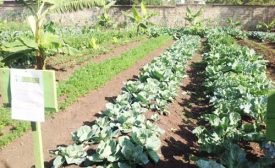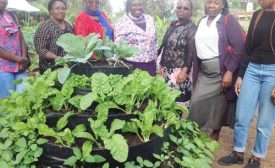This is the story of Mrs Mary Kamau who has 36 years experience in AEAS and who has gone throught very diverse experiences being Director of Extension and Training in Kenya and Chair of AFAAS. Today, she is still active as Board Member of GFRAS, AFAAS, KEFAAS, Access Agriculture and as an Agri-Consultant and Farmer.
![]()
 It all started in mid-1980 when I was employed by the Government of Kenya in the then Ministry of Agriculture and Livestock Development as an Agriculture Officer II. I was a fresh graduate from the University Of Nairobi at the time. I was able to grow and nurture my career over the years within the Ministry until 2016 when I retired as the first female Director of Agriculture Extension and Training Services.
It all started in mid-1980 when I was employed by the Government of Kenya in the then Ministry of Agriculture and Livestock Development as an Agriculture Officer II. I was a fresh graduate from the University Of Nairobi at the time. I was able to grow and nurture my career over the years within the Ministry until 2016 when I retired as the first female Director of Agriculture Extension and Training Services.
I wish to share my long experience in working with the farming community and other stakeholders in the delivery of Agriculture Extension and Advisory Services (AEAS), the challenges involved, the successes achieved, the lessons learned, and my thoughts/recommendations.
![]()
Kenya, like most developing countries in Africa, heavily relies on agriculture as the mainstay of the Economy. It contributes to 25% of the Gross Domestic Product (GDP) directly and 27% indirectly, 75% of industrial materials, 65% of total exports, and employs more than 80% of the rural population. Kenyan Agriculture is predominately carried out by over five million small scale farmers, who produce more than 60% of the total farm produce. These statistics create a strong case for the need to empower farmers with improved technology to increase basic income levels, guarantee perennial food security, and ensure overall agricultural development.
During pre-independence or before the early 60s, the AEAS approaches were mainly tailored/forced to cater to the white settlers and commercial farming systems. There were well-packaged policies; programs that ensured that AEAS was combined with subsidized inputs supply and credit; and elaborate marketing systems to ensure the supply of produce to the European Markets.
After independence in 1963, we adopted more persuasive and educational AEAS approaches and methods that were implemented mainly through donor-funded projects/programs compounded by well-coordinated research systems.
The approaches were:
- Farmer Training Centers (FTC)
- Whole-Farm Extension Approach (WFEA)
- Integrated Agricultural Development (IAD)
- Farming System (FS)
- Training and Visit (T&V)
- Commodity Extension by Parastatals and Cooperative Societies
- Focal Area Approach (FAA)
- Farmer Field School Approach (FFSA)
- Group Approach
- Individual Farm Visit Approach (IFVA)
- Catchment Approach
These approaches were in vogue until 2000 when other approaches came on board such as;
- Demand-Driven Approach
- Market Oriented Approach
- Agricultural Information Desk Approach (AIDA)
- Agri-business Approach
- Agricultural Product Value Chain Approach
- E-Extension
- Media & Video Extension
Urban agriculture with vertical farming during Field Day in Kenya




It is important to note that the approaches before the year 2000 had high manpower demands (staff to farmer ratio of 1:600), were time-consuming, and required a tremendous amount of financial resources. The approaches were essentially top-down and lacked participation and involvement of the relevant stakeholders. However, the linkage between research and extension was very cohesive; the input supply system was excellent; markets for the produce was assured through cooperative societies and government parastatals boards that handled various export and cereals crops.
This model of operation made agricultural production thrive exponentially up to the end of the 1980s when the Structural Adjustment Program (SAP) curtailed the recruitment of Government AEAS providers and the liberation of the Agricultural Sector set in the early 90s. Most of the marketing channels broke down (marketing through Parastatal Boards). Most of the cooperative societies’ systems were eroded. The net performance of AEAS and agriculture development as a whole dropped significantly. Fundamentally this decline was also due to the simple fact that without guaranteed markets, no matter the approach, farmers were not interested. These problems persisted throughout the 1990s.
Due to the above scenario, agricultural and economic growth was greatly affected. The country’s economic growth sank to a low of 2% annually by early 2000. In 2002, the New Government Regime came up with a blueprint to revive the Economy dubbed the Economic Recovery Strategy for Wealth Creation (ERSWEC). Every Ministry was instructed to come up with a comprehensive strategy that led to the inception of “The Strategy to Revitalize Agriculture 2004-14” in which Agriculture Extension and Advisory Services (AEAS) was earmarked as of one of the fundamental pillars required to spur agricultural development. The improvement of the delivery of research, extension, and advisory support services; the review and harmonization of agriculture legal, regulatory, and institutional frameworks; were among the six fast-track interventions selected to achieve the envisioned goals.
Due to the creation of an enabling environment by the government, where the farmers were empowered and staff motivated, the agricultural and economic growth jumped to 7% annually by 2007. AEAS became vibrant once more and having been appointed the Extension and Training Director in the same year; I championed the formulation of the National Agricultural Sector Extension Policy (NASEP) which was enacted by the President in 2012, the first one in Africa. Many other African countries have since followed suit.

The gist of the Policy was:
- Pluralism and collaboration/networking with other stakeholders in extension which was predominantly in the hands of the government (90%).
- DrCreation monization of extension services provision.
- Enhemand-driven extension services.
- Haancing Public-Private Partnership (PPP).
- Creation of a regulatory body to ensure quality assurance.
- of an Extension Trust Fund to finance extension.
- Capacity development of the extension providers.
- Strong linkage between extension and research/innovation systems.
- Modernization of extension methodologies/approaches.
- Empowerment of farmers to implement improved extension technologies.
- Development of community information systems networks.
- Incorporation of mainstream cross-cutting issues especially, gender and youth in extension
After the policy was put in place, an implementation framework was created to actualize the recommendations. AEAS modernization took off and we launched E-Extension by 2011 along with various tools to promote it. By the end of 2012, the AEAS systems were doing very well and the government in collaboration with other stakeholders embraced a more participatory AEAS approach which was demand-driven, brought PPP on Board, empowered farmers, put marketing systems in place, motivated agricultural extension staff, and mentored youth in agriculture projects. AEAS was adequately financed by the government and the private sector. There were also extension guidelines put in place and an extension handbook was created to outline these guidelines.
In 2015, we launched our Country Forum (KEFAAS) a cascade of AFAAS Regional Network which we are a member of. However, despite all the accrued success from the last 15 years, all hell broke loose when AEAS was devolved to 47 County Governments in 2013 following the promulgation of Kenya’s new Constitution in 2010. To date, AEAS in more than 75% of the counties have been neglected and all the gains achieved have eroded but the Country Forum (CF) is determined to make a difference.
![]()
Conclusion:
- Markets and marketing systems drive AEAS.
- No single AEAS approach is a perfect fit for all delivery of services. Each country should use the most appropriate approaches which are sustainable and affordable.
- Every Country/Region should use a combination of approaches appropriate for different areas, communities, and commodities. They have to be simple, affordable, applicable, demand-driven, and market-oriented for them to realize any success.
- Have an extension policy to guide extension direction, “If you don’t know where you are going, it doesn’t matter the route you take”
- Empower extension providers and farmers to take up improved technology. Capacity Development for all the providers is a must.
- Markets and marketing are the keys to successful extension and advisory systems.
- Finance extension AEAS capacity development.
- Embrace PPP for harmonization and financing of AEAS but ensure quality.
- Mentor, guide, and empower youth in agriculture extension and development. They are the future and are conversant with modern technology.
- Enhance a strong linkage between research and innovation sources.
- Empower platforms that share experiences, knowledge, and innovation.
- Document case studies and have elaborate communication systems to share.
- Modernize AEAS through the use of modern tools e.g. ICT applications, instructional videos, etc. to ensure comprehensive AEAS coverage.
- Strengthen the respective Country Fora. They are the pillars of regional and global networks.
Just my experience and thoughts.
